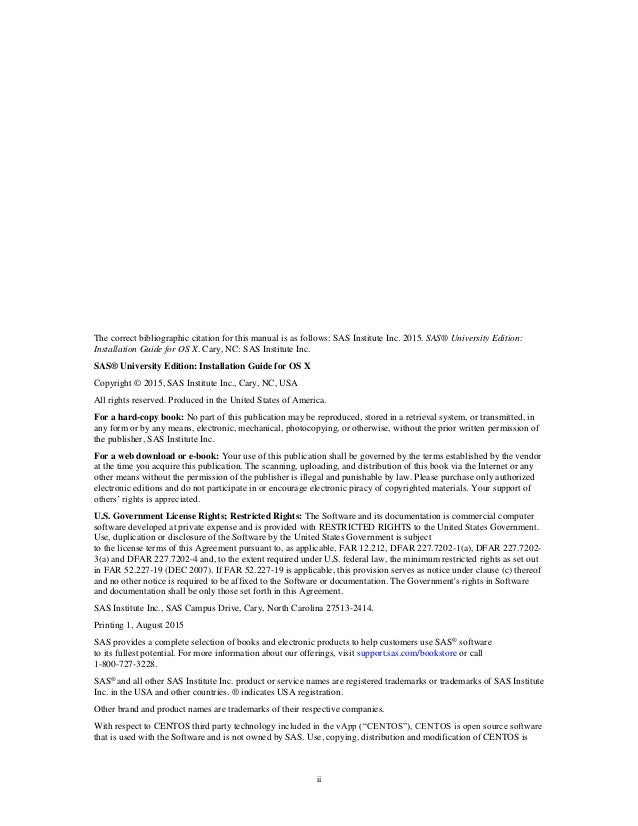Teachers, students, independent learners, and academic researchers can download this software for free if it's used for noncommercial learning purposes. It includes Base SAS®, SAS/STAT®, SAS/IML®, SAS/ACCESS® Interface to PC Files and SAS® Studio. Once you've downloaded the software to your PC, Mac, or Linux workstation, SAS works locally on your machine by using virtualization software and your browser, so no Internet access is required. Or you can get SAS University Edition for free via AWS Marketplace (AWS usage fees may apply).
- Sas Enterprise Guide User Manual
- Sas University Edition Mac Users Manual 2017
- Sas University Edition Mac Users Manual 2017
Sas Enterprise Guide User Manual
SAS University Edition app after it has been installed on my Macintosh? The downloaded installation file has the name 'unvbasicova'. I'm trying to completely uninstall all software modules associated with the SAS University Edition whose license expired in July, before attempting reinstallation of a just downloaded version of the said app.
For more features, see SAS University Edition: Help Center.
Get Started
Get free software for teaching and learning SAS skills that you can use in introductory to advanced-level statistics and quantitative methods classes, or in self-directed learning. These resources are a great place to start.
View a demonstration of how SAS University Edition can be used to explore data, run analyses and write SAS programs using the SAS Studio interface.
Read about the key features of SAS University Edition and how you can use it to expand your analytical skills.
Because SAS University Edition is a virtual application, you need virtualization software to run it. Get started by learning how to download the virtualization software, download the SAS University Edition vApp, and set up shared folders to access your data.
- Download SAS University Edition for free.

You can also choose to run SAS University Edition in the cloud by using Amazon Web Services Marketplace. Read about some of the differences in this tutorial:
Stay connected
Be part of the SAS University Edition community. We offer a variety of ways for you to interact with users and experts.
- Join a users group
Tutorials
Browse our library of free SAS University Edition tutorials. Learn something new. Sharpen your skills.
View an overview of SAS software and the various user interfaces.
Learn how to view a data table, write and submit SAS code, view the log and results, and quickly generate graphs and statistical analyses.
Learn how to access your existing local files using the SAS Studio interface and in SAS program code.
- What are the components of a SAS program?
- How do I write a SAS program?
- How does SAS Studio help me write programs?
- How do I run a SAS program?
- Writing a Basic SAS Program (Video)
- How do I reference SAS data from within a program?
Advanced Tutorials
Expand your SAS University Edition skill set with next-level tutorials.
Learn to extract data from one or more tables according to criteria that you specify.
Advanced Tutorials
Learn SAS technology quickly and efficiently by taking a course from the analytics experts.
Sas University Edition Mac Users Manual 2017
Find user's guides and other technical documentation for SAS University Edition.
Online Documentation

Sas University Edition Mac Users Manual 2017
- Installation Guide Amazon Web Services
- Installation Guide Mac
- Installation Guide Windows
- Installation Guide Linux
- Quick Start for Amazon Web Services
- Quick Start for VirtualBox
- Quick Start for VMwarePlayer
- Quick Start for VMwareFusion
- Quick Start for Students with Visual Impairments
Documentation for Products Included with SAS University Edition
Connect with other SAS users by joining a users group or attending an upcoming event.
Table of Contents
- Part 1: Getting Acquainted with the SAS Studio Environment
- Chapter 1: Introduction to the SAS University Edition
- Chapter 2: The SAS Studio Interface
- Chapter 3: Importing Your Own Data
- Chapter 4: Creating Reports
- Chapter 5: Summarizing Data Using SAS Studio
- Chapter 6: Graphing Data
- Part 2: Learning How to Write Your Own SAS Programs
- Chapter 7: An Introduction to SAS Programming
- Chapter 8: Reading Data from External Files
- Reading Data Values Separated by Delimiters
- Reading Data in Fixed Columns
- Reading Excel Files
- Chapter 9: Reading and Writing SAS Data Sets
- Chapter 10: Creating Formats and Labels
- Chapter 11: Performing Conditional Processing
- Chapter 12: Performing Iterative Processing: Looping
- Leaving a Loop Based on Conditions (DO WHILE and DO UNTIL Statements)
- Chapter 13: Working with SAS Dates
- Chapter 14: Subsetting and Combining SAS Data Sets
- Chapter 15: Describing SAS Functions
- Describing Some Useful Numeric Functions
- Describing Some Useful Character Functions
- Chapter 16: Working with Multiple Observations per Subject
- Chapter 17: Describing Arrays
- Chapter 18: Displaying Your Data
- Chapter 19: Summarizing Data with SAS Procedures
- Chapter 20: Computing Frequencies